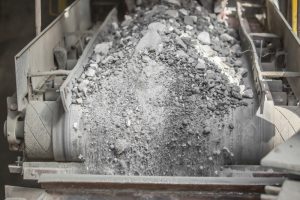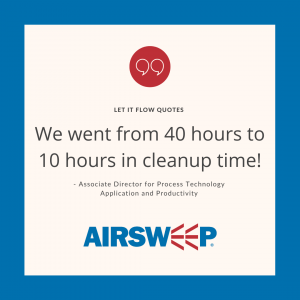Solve Cement Flow Issues with AirSweep
Comments Off on Solve Cement Flow Issues with AirSweep
Cement is an important building material with the global demand expected to reach 4.73 billion tons by 2025. However, many cement plants struggle to keep up with production because of bulk solid flow problems. Materials like limestone, slag, bauxite, gypsum, and clay are prone to bridging, ratholing, and flooding. Moisture—especially in Asia and other humid environments—can also harden materials during storage.
Plant operators often resort to makeshift solutions like hammering the vessel. However, this seemingly “cheap fix” is slow and has hidden costs: slow productivity, safety risks, and damage to the vessels. Flow aids can help clear out material blocks and improve production, but it is necessary to find one that is effective for cement materials.
4 Factors When Selecting a Flow Aid for the Cement Industry
- Material activation. The flow aid must be able to handle heavy materials and large volumes. Some flow aids like fluidizers, which use a combination of gentle air pulses and vibration, are only effective for light powders that respond to light aeration.
- Energy consumption. Air cannons and air knockers have more power than fluidizers, but also require a lot of energy and plant air. Vibrators can also be expensive to operate because they run continuously. This is a big factor for countries that have high electricity prices, particularly in Asia and Europe.
- Reliability. Ideally, flow aids provide on-demand, first-in / first-out flow. Stagnant material left in the vessel can compromise product consistency and safety. For example, some additives like magnesium oxide can add strength but must be used in precise quantities so the product remains stable.
- Maintenance time and cost. Part of productivity includes shortening maintenance and cleaning times. Flow aids that are installed outside of the vessel, and can easily be removed even when they are located higher up in the silo or hopper, can significantly simplify routine maintenance.
AirSweep is One of the Most Trusted Flow Aids in the Cement Industry
AirSweep is a pneumatic flow aid that releases high-pressure, high-volume, 360-degree bursts of compressed air, which lifts stalled material back into the flow stream. It is used by cement companies around the world, such as Heidelberg Cement, Republic Cement, Cemex, Mississippi Lime, Carmeuse, and more.
AirSweep is proven effective for cement materials such as:
- Aluminum
- Bentonite
- Coal
- Copper
- Diatomaceous earth
- Gypsum
- Iron ore
- Limestone
- Magnetite
- Phosphate
- Shale
- Soda Ash
This material flow test demonstrates AirSweep’s effectivity for gypsum pebbles, which are used in the cement industry as a hardening retarder.
AirSweep Increases Cement Production by 60% Overnight
A Pennsylvania concrete company with six ready-mix plants was experiencing problems with fly ash bridging in bins, halting production.
After the AirSweep units were installed, fly ash moved freely from the bin to the ready-mix truck. “Production went from zero percent to 100 percent overnight after installing the AirSweep units,” stated the quality control technical service manager at the plant. The plant increased production by 60 percent.
AirSweep Works Better Than Industrial Vibrators for Cement Materials
An Asian cement company needed a flow rate of 30 tons per hour, but humidity caused shale to clog the silos. They lost $12,000 per hour of downtime. They tried numerous flow aids, such as vibrators, but workers still had to hammer the vessels to clear out all the material. This happened so frequently that they developed a formula for the cost of downtime on their monthly reports.
Vibrators and air knockers didn’t work. Only AirSweep produced reliable flow – and even used half as much energy as other flow aids.
AirSweep Proves More Powerful Than Air Cannons and Air Knockers
Heidelberg Cement, one of the largest building materials companies in the world, previously used air cannons to clear cement clinker from vessel walls and pipes. “We were using a bar to [break] the material in the tube.”
They replaced air cannons with AirSweep. “They worked perfectly.” Heidelberg Cement was so happy with the results that in the last year, they ordered 13 additional units for their various factories. “This is only the beginning of the project.”
AirSweep Meets All the Criteria for a Cement Flow Aid
- Material activation. AirSweep’s powerful air pulses are able to lift all material back into the flow stream. You don’t need to have workers hammer or climb into the vessel with pick axes and other tools to clear out blocks and residue.
- Energy consumption. AirSweep uses less energy and plant air than other flow aids. It also uses controlled pulses which are released in sequence, instead of running continuously.
- Reliability. AirSweep promotes on-demand, first-in / first-out flow. It even flushes the walls clean, ensuring product consistency and integrity.
- Maintenance time and cost. AirSweep units are installed outside of the vessel, and can easily be removed with simple tools for routine maintenance and cleaning.
For more information on AirSweep in the cement industry, visit this page or contact us.
AirSweep Cuts Back on Cleaning Time
Comments Off on AirSweep Cuts Back on Cleaning TimeIf you are looking to cut back on cleaning time then you need AirSweep.
When you are cleaning your vessels, do you need to manually clean them, or flush them with flour or other materials?
We have a better way to clean your vessels and save you time and money.
An infant formula company produces several varieties and milk formulations in the same processing and packaging lines. They used AirSweep during production to prevent segregation, and after production to flush the vessels completely clean – this cut their cleanup time by 75%!

Are you curious about how AirSweep can help your process? Contact us and we’ll be happy to customize a proposal for you.
The Hidden Cost of Ineffective Material Flow Aids
Comments Off on The Hidden Cost of Ineffective Material Flow Aids
Flow aids can resolve bridging, arching, and other material blocks, but many give limited results and come with hidden costs. So instead of solving the problem, they can even create new ones—and hinder productivity and revenue.
Hammers and Manual Cleaning
Hammers are the cheapest flow aid you can possibly find… or so you think. While you can get a hammer for less than $20, you’re actually paying for manpower hours and the downtime while workers clear out the clogged material from the vessel.
That can be very expensive. One of the biggest cement companies in Southeast Asia calculated that they lost $12,000 per hour of downtime. In North America, this downtime is more like $25,000 an hour.
Hammering can also damage machines, and it creates the risk of worker injury. It’s also very inefficient: material can still cling to vessel walls compromising product consistency and even leading to spoilage.
Fluidizers
Fluidizers are sometimes the default flow aid because they have already been pre-fitted into the vessel. The rubber disks are connected to air piping and use a combination of gentle vibration and aeration to activate the material.
While the fluidizers work for very light powders like flour, they can’t activate heavy, damp, or sticky materials. They have a small effective radius, so you may need to install several units. Since the disks run continuously, energy consumption is also high.
Fluidizers that are installed inside the vessel can also degrade, and material can be trapped inside the disks. This is a risk for sanitary processes and it creates cleaning and maintenance challenges.
Industrial Vibrators
Vibrators, as the name implies, vibrate the material to shake it free from the vessel wall and collapse any bridging and blocks.
However, many materials can actually become more compact when it is shaken. In fact, vibrators are sometimes used to compress materials before they are stored or transported. That’s effective in a warehouse, but not in a silo or hopper where you want materials to move.
Even for materials to respond to vibration, this flow aid can still be problematic. It can cause metal fatigue and eventually lead to vessel damage. It uses a lot of air and energy to operate. It does not completely flush material that clings to walls or pipes, so you will still need to do periodic shutdowns for cleaning.
Air Cannons
This flow aid blasts air through material blocks. While powerful, it is not always effective. Air can channel through the holes and diminish its effect. It requires a large amount of plant air and energy to operate, and will still leave a lot of material on the vessel that needs to be manually cleaned.
The large units are also difficult to install in small vessels, and the metal recoil contributes to vessel wear and tear. Flying material can also enter the nozzle and solenoid valve, so the system is prone to damage and maintenance issues.
How to Find the Most Efficient Flow Aid
When selecting a flow aid, don’t just look at the initial cost of installation. Look at the hidden costs—downtime and manual labor, consumption of energy and plant air, cleaning and maintenance, and even the financial and legal impact of a worker injury.
To avoid these costs, select a flow aid based on these factors:
- Speed and efficiency. How fast will your material flow? Will it shorten your production time? Can the flow aid remove all stagnant material, or will you still need to hammer or manually clean your vessels?
- Operating costs. How much energy does it consume during operation? Does it use energy efficiently, i.e. will the units run continuously or in short, specific durations? What is the cost of cleaning and maintaining the flow aid itself, and how does it impact the maintenance of the vessel in which it is installed?
- Hygiene and safety. Consider risks to your product quality (like material contamination and spoilage) and risks to your people (worker injuries during manual cleaning, etc.).
Companies Choose AirSweep as the Most Cost-Effective Flow Aid
Many plants that used fluidizers, vibrators, and other flow aids eventually switched to AirSweep because they got better results. It improved productivity, product quality, and had lower energy and maintenance costs.
You can read about 7 companies that switched from vibrators to AirSweep or see how AirSweep’s features compare to the other flow aids in the market.
If you have any other questions about AirSweep or need more information about how it can work on your process, contact us for a personal consultation or customized proposal.




